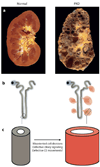Planar cell polarity signaling: from fly development to human disease
- PMID: 18710302
- PMCID: PMC2814158
- DOI: 10.1146/annurev.genet.42.110807.091432
Planar cell polarity signaling: from fly development to human disease
Abstract
Most, if not all, cell types and tissues display several aspects of polarization. In addition to the ubiquitous epithelial cell polarity along the apical-basolateral axis, many epithelial tissues and organs are also polarized within the plane of the epithelium. This is generally referred to as planar cell polarity (PCP; or historically, tissue polarity). Genetic screens in Drosophila pioneered the discovery of core PCP factors, and subsequent work in vertebrates has established that the respective pathways are evolutionarily conserved. PCP is not restricted only to epithelial tissues but is also found in mesenchymal cells, where it can regulate cell migration and cell intercalation. Moreover, particularly in vertebrates, the conserved core PCP signaling factors have recently been found to be associated with the orientation or formation of cilia. This review discusses new developments in the molecular understanding of PCP establishment in Drosophila and vertebrates; these developments are integrated with new evidence that links PCP signaling to human disease.
Figures




References
-
- Adler PN. Planar signaling and morphogenesis in Drosophila. Dev. Cell. 2002;2:525–535. - PubMed
-
- Adler PN, Liu J, Charlton J. Cell size and the morphogenesis of wing hairs in Drosophila. Genesis. 2000;28:82–91. - PubMed
-
- Ahumada A, Slusarski DC, Liu X, Moon RT, Malbon CC, Wang HY. Signaling of rat Frizzled-2 through phosphodiesterase and cyclic GMP. Science. 2002;298:2006–2010. - PubMed
-
- Axelrod JD. Basal bodies, kinocilia and planar cell polarity. Nat. Genet. 2008;40:10–11. - PubMed
Publication types
MeSH terms
Grants and funding
LinkOut - more resources
Full Text Sources
Other Literature Sources
Molecular Biology Databases

